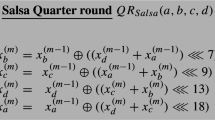Abstract
In this paper, we study the effect of diagonal constants in the software oriented stream ciphers Salsa and Chacha. So far, there has not been any clear justification why such constants are chosen. We concentrate on differential cryptanalysis to evaluate how different constants affect the biases after a few rounds in these ciphers. We are using Measure of Uniformity in bias as a measure for differentiating constants as good or bad constants w.r.t. original constant. We have observed that after 4 rounds of Salsa20, for an Input Differential (\(\mathcal {ID}\)) at Most Significant Bit (MSB) of the third word of quarterround function, the specific patterns in constant involved in that quarterround function leads to increase or decrease in Measure of Uniformity in bias. The location of specific patterns in those diagonal constants varies with the change in last two rotation constants. We did not observe any pattern for ChaCha after 3 rounds. We have also observed a slight increase and decrease in time and data complexity for good and bad constants respectively as compared to an original constant. The designer constants are a good constant however it can be even better with a slight change in constant \(c_0\) or \(c_3\).
Access this chapter
Tax calculation will be finalised at checkout
Purchases are for personal use only
Similar content being viewed by others
References
Ashur, T., Liu, Y.: Rotational cryptanalysis in the presence of constants. IACR Cryptology ePrint Archive 2016, 826 (2016). http://eprint.iacr.org/2016/826
Aumasson, J.-P., Fischer, S., Khazaei, S., Meier, W., Rechberger, C.: New features of Latin dances: analysis of Salsa, ChaCha, and Rumba. In: Nyberg, K. (ed.) FSE 2008. LNCS, vol. 5086, pp. 470–488. Springer, Heidelberg (2008). https://doi.org/10.1007/978-3-540-71039-4_30
Bernstein, D.: Salsa20 security (2005). http://cr.yp.to/snuffle/security.pdf
Bernstein, D.J.: Salsa20 specification. eSTREAM Project algorithm description (2005). http://www.ecrypt.eu.org/stream/salsa20pf.html
Bernstein, D.J.: ChaCha, a variant of Salsa20. In: Workshop Record of SASC, vol. 8 (2008)
Hernandez-Castro, J.C., Tapiador, J.M.E., Quisquater, J.-J.: On the Salsa20 core function. In: Nyberg, K. (ed.) FSE 2008. LNCS, vol. 5086, pp. 462–469. Springer, Heidelberg (2008). https://doi.org/10.1007/978-3-540-71039-4_29
Choudhuri, A.R., Maitra, S.: Significantly improved multi-bit differentials for reduced round salsa and chacha. IACR Cryptology ePrint Archive 2016, 1034 (2016). http://eprint.iacr.org/2016/1034
Crowley, P.: Truncated differential cryptanalysis of five rounds of Salsa20. IACR Cryptology ePrint Archive 2005, 375 (2005). http://eprint.iacr.org/2005/375
The ECRYPT stream cipher project. eSTREAM portfolio of stream ciphers. http://www.ecrypt.eu.org/stream/
Fischer, S., Meier, W., Berbain, C., Biasse, J.-F., Robshaw, M.J.B.: Non-randomness in eSTREAM candidates Salsa20 and TSC-4. In: Barua, R., Lange, T. (eds.) INDOCRYPT 2006. LNCS, vol. 4329, pp. 2–16. Springer, Heidelberg (2006). https://doi.org/10.1007/11941378_2
Ishiguro, T., Kiyomoto, S., Miyake, Y.: Latin dances revisited: new analytic results of Salsa20 and ChaCha. In: Qing, S., Susilo, W., Wang, G., Liu, D. (eds.) ICICS 2011. LNCS, vol. 7043, pp. 255–266. Springer, Heidelberg (2011). https://doi.org/10.1007/978-3-642-25243-3_21
Maitra, S.: Chosen IV cryptanalysis on reduced round ChaCha and Salsa. Discret. Appl. Math. 208, 88–97 (2016). http://www.sciencedirect.com/science/article/pii/S0166218X16300841
Maitra, S., Paul, G., Meier, W.: Salsa20 cryptanalysis: new moves and revisiting old styles. In: WCC 2015, the Ninth International Workshop on Coding and Cryptography, Paris, France, 13–17 April 2015 (2015). http://eprint.iacr.org/2015/217, http://eprint.iacr.org/2015/217
Mouha, N., Preneel, B.: A proof that the ARX Cipher Salsa20 is secure against differential cryptanalysis. IACR Cryptology ePrint Archive 2013, 328 (2013). http://eprint.iacr.org/2013/328
Shi, Z., Zhang, B., Feng, D., Wu, W.: Improved key recovery attacks on reduced-round Salsa20 and ChaCha. In: Kwon, T., Lee, M.-K., Kwon, D. (eds.) ICISC 2012. LNCS, vol. 7839, pp. 337–351. Springer, Heidelberg (2013). https://doi.org/10.1007/978-3-642-37682-5_24
Tsunoo, Y., Saito, T., Kubo, H., Suzaki, T., Nakashima, H.: Differential Cryptanalysis of Salsa20/8 (2007). http://ecrypt.eu.org/stream/papersdir/2007/010.pdf
Velichkov, V., Mouha, N., De Cannière, C., Preneel, B.: UNAF: a special set of additive differences with application to the differential analysis of ARX. In: Canteaut, A. (ed.) FSE 2012. LNCS, vol. 7549, pp. 287–305. Springer, Heidelberg (2012). https://doi.org/10.1007/978-3-642-34047-5_17
Acknowledgements
The authors would like to thank anonymous reviewers for detailed comments. The authors are also thankful to Computer Division of Bhabha Atomic Research Centre for use of super computing facility.
Author information
Authors and Affiliations
Corresponding authors
Editor information
Editors and Affiliations
Rights and permissions
Copyright information
© 2017 Springer International Publishing AG
About this paper
Cite this paper
Bathe, B.N., Hariramani, B., Bhattacharjee, A.K., Kulgod, S.V. (2017). Analysis of Diagonal Constants in Salsa. In: Ali, S., Danger, JL., Eisenbarth, T. (eds) Security, Privacy, and Applied Cryptography Engineering. SPACE 2017. Lecture Notes in Computer Science(), vol 10662. Springer, Cham. https://doi.org/10.1007/978-3-319-71501-8_6
Download citation
DOI: https://doi.org/10.1007/978-3-319-71501-8_6
Published:
Publisher Name: Springer, Cham
Print ISBN: 978-3-319-71500-1
Online ISBN: 978-3-319-71501-8
eBook Packages: Computer ScienceComputer Science (R0)




